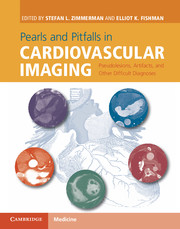 Pearls and Pitfalls in Cardiovascular Imaging
Pearls and Pitfalls in Cardiovascular Imaging from Section 2 - Cardiac aneurysms and diverticula
Published online by Cambridge University Press: 05 June 2015
Imaging description
Aneurysm of the membranous ventricular septum appears as a thin-walled, round or lobulated outpouching of the basilar ventricular septum just inferior to the aortic valve annulus (Figure 17.1). It bulges into the right ventricle because of higher left ventricular pressure; however, it may change in size dynamically during the cardiac cycle. Signal characteristics on imaging match the left ventricular blood pool (Figure 17.2), unless complicated by thrombus. Membranous septal aneurysms (MSA) are wide-necked and typically measure 10–15 mm in size; however, much larger aneurysms have been reported.
Importance
Membranous ventricular septal aneurysms may be incorrectly diagnosed as sinus of Valsalva aneurysms or cardiac masses, potentially leading to inappropriate surgery and patient anxiety. Membranous septal aneurysms generally have a benign course; however, thrombus formation, right ventricular outflow tract (RVOT) obstruction, rupture, and infection have been reported.
Typical clinical scenario
Membranous septal aneurysms are typically incidentally diagnosed at echocardiography, cardiac CT, or cardiac MRI. They are rare congenital malformations and when found in children, are often associated with other types of congenital heart disease with an estimated prevalence of 0.3% in children with congenital heart disease. When diagnosed in children, membranous septal aneurysms are associated with a ventricular septal defect (VSD) and left-to-right shunt in approximately 20% of cases and some experts believe they may play a role in spontaneous closure of these shunts. Given this association, identification of a membranous septal aneurysm should prompt evaluation for membranous defect and left-to-right shunt. There is an increased incidence of atrioventricular block in patients with membranous septal aneurysms.
Differential diagnosis
The primary differential diagnosis is a sinus of Valsalva aneurysm. These originate above the level of the aortic valve annulus; however, similar to MSA they can protrude into the right ventricular outflow tract. Periaortic pseudoaneurysm due to endocarditis may also have a similar appearance; however, patients will have an abnormal aortic valve and will be quite ill.
To save this book to your Kindle, first ensure [email protected] is added to your Approved Personal Document E-mail List under your Personal Document Settings on the Manage Your Content and Devices page of your Amazon account. Then enter the ‘name’ part of your Kindle email address below. Find out more about saving to your Kindle.
Note you can select to save to either the @free.kindle.com or @kindle.com variations. ‘@free.kindle.com’ emails are free but can only be saved to your device when it is connected to wi-fi. ‘@kindle.com’ emails can be delivered even when you are not connected to wi-fi, but note that service fees apply.
Find out more about the Kindle Personal Document Service.
To save content items to your account, please confirm that you agree to abide by our usage policies. If this is the first time you use this feature, you will be asked to authorise Cambridge Core to connect with your account. Find out more about saving content to Dropbox.
To save content items to your account, please confirm that you agree to abide by our usage policies. If this is the first time you use this feature, you will be asked to authorise Cambridge Core to connect with your account. Find out more about saving content to Google Drive.